5/14
Xi'an
v31. Daybreak in Shaanxi.
The train rattled on the last couple hours, and I bailed out, did not find a tourist bus, spent 35 cents on breakfast, and decided to do the city wall stuff first, in full pack.

0503. Castle in the north wall.

0504. Blocked-off staircase.

0505. Disused access gate, northeast corner.

0506. Garden wall inside the east wall.

0507. Peacock in temple grounds by one of the east gates.

0508. Temple front.

0509. East gate house over some trees.

0510. More towards the front; this is the version of the shot with the least bus in it.

0511. Inside the east gate. I got here just at the 0800 opening time. Go me, hiking most of 2.3 km in about 45 minutes, under full pack, through traffic.

0512. It's less severe than the Great Wall, but the wear pattern's the same.

0513. Main castle over the east gate.
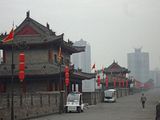
0514. Watchtowers stretching south.

0515. Apartments consonant with the wall. In a rare case of aesthetic rather than relentlessly practical city planning, most of the high-rises in Xi'an are outside the walls, and most of what's inside doesn't go much more than a story or two taller than them.

0516. Quality control marks in the paving flags.

0517. More modern stamps.

0518. Corner watchtower, southeast.

0519. Around and down to the west.

0520. Moat and parkland.

0521. Ornamental lanterns, modern highrise.

0522. Back north on the outside of the east wall.

0523. The outside of the south wall.

0524. At a pagoda like 1.5 km away (center). The air didn't feel that bad....

0525. Restored watchtower detail.

0526. Old guardhouse.

0527. Grass on the roof.

0528. Further west to the Examinations Temple.
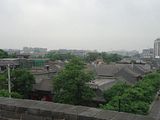
0529. The Wolong (Lying (down) Dragon) monastery.

0530. Front of the temple area.

0531. Story of a Japanese ambassador.

0532. An exhibit on bikes of China, by the southern walltop bike rental place.

0533. Courtyard of the south gate.

0534. Drums below the wall.
v32. I got over right in time to film most of this cool daily opening ceremony. Starts at 0900, don't miss if you're in town.
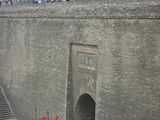
0535. Old legend over the gate.
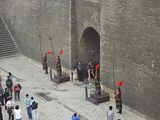
0536. Warriors on guard.

0537. Along the south moat.

0538. Temple by the south gate.
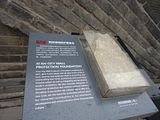
0539. Original stone and donation box for further restoration.

0540. The drums up close.

0541. Old block plan, within and without the walls.

0542. Outer castle of the south gate from below.

0543. Out through the walls.

0544. And into central Xi'an.
I hiked east a bit along the wall, and after a bar street (the "German" bar was advertising Carlsberg, and the "American" one had Franzi), I got to the Xi'an Beilin Bowuguan, the Forest of Steles Museum.

0545. Main gate in.

0546. Tree growing through an outbuilding.

0547. Raw wooden pavilion.

0548. Roof over the trees.

0549. Bell and inscription.

0550. Inside a pavilion -- inscriptions in Chinese and another script, probably Vedic if it's scripture, Arabic if it's a secular order/proclamation, not legible to me either way.

0551. Ornaments on the steps.

0552. Back of a courtyard stele; faint carvings of birds.
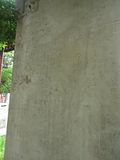
0553. The front side.

0554. Supported by a turtle. Most of the steles later inside are as well, but this dood is mostly underground.
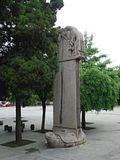
0555. Stele and trees.

0556. Inside the first hall; walls and walls of the Twelve Classics.

0557. Close up on the text.

0558. Not without damage; I'm not sure if the barred bits are effacements or hexagrams from the Tao Te Qing.

0559. Top of the Nestorian Stele.

0560. Bottom and slate. While most of Europe was still battling it out for pagan or Christian hegemony, the Church came to China by the Silk Road, hung around for three or four hundred years, and then got displaced by Islam from the same source. Nestorian Christianity in post-Hellenic, pre-Mongol Central Asia is a fascinating subject, and a continual reminder that the way you think antiquity worked is probably wrong; if it took heroic white Christian explorers to 'open' the far east, Japanese temple sculptures wouldn't be so clearly influenced by Greek classicism -- and the Stoics certainly wouldn't've built on Zen Buddhism, among other sources, going the other way.

0561. Cursive stele from the Tang dynasty.

0562. Close up; you occasionally see these forms in seals and logos, but not anywhere that needs immediate legibility.

0563. Tablet from the mid-6th-century; most of the characters are basically in their modern forms.

0564. Inset from a stele of 177 AD; still pretty much as readable as any newspaper.
Western antiquarians may be wondering what the point, exactly, is of this; there's a lot of well-preserved relics from the Roman and Greek world that can still be read today. That's true, but they can only be read if you speak Latin or Classical Greek. Any Chinese person who's graduated high school can read these steles as easily and with the same meaning as the day they were carved. Pronunciations may have changed over the centuries, but the character forms are remarkably consistent, and while the Chinese government simplified the character set in the '50s, the radicals are for the most part recognizable between their simplified and traditional forms, and the basic plan of combining meaning and pronunciation radicals into more complex characters has been the same since the language was defined. That's the thing about China's "4000 years of history" -- most of it is immediately accessible to everyone, not just to scholars.

0565. A scene of Mt. Taibai.

0566. Worker preparing a demonstration slab for a rubbing.

0567. Close up on calligraphic chisel work.

0568. Outside; end of a hall.

0569. Tree in a courtyard.

0570. Inside one of the pavilions.

0571. Stone horse of Daxia. Hun khans didn't go in for "writing that doesn't look like anything", so this stele is shaped like a horse.

0572. Jin gate, heading out.
So eventually, after entirely too much hiking, I got to the hotel much too early, then drank my lunch, wrote this up, and prepped for the bell/drum towers and the Muslim quarter for this afternoon. If I can't find reliable stops for the noted tourist buses by tonight, I'll do Terracotta Warriors by cab tomorrow and hop a bus back; if I can't make a 19:45 train from an attraction with 3 hours total travel time on a 0700 standing start, there is something wrong with me. Even a UNESCO World Heritage Site in full pack.

0573. Down from the bell tower.

0574. Up at the facade.

0575. Across the doors.

0576. Bell out front.

0577. Along to the drum tower.

0578. More of the bell tower.

0579. Qing edicts inside.

0580. Detail in Arabic for parts west of here. All the edict scrolls on display at the bell tower are bilingual.

0581. Replica bells for a performance. I wasn't going to sit and wait a half hour for it, though...

0582. Ceiling inside the bell tower.

0583. Lamps and more detail.
0584. (DNCO).

0585. Inside the upper level.

0586. More roof beams.

0587. Stunning flowers below.

0588. Workman's tag on a pillar.

0589. Scenes from mythology and the classics on the doors.

0590. Lamp detail coming down.

0591. Outside the bell tower.

0592. Drum and corner at the drum tower.

0593. Long row of drums.

0594. Watch drum and slate.

0595. Nifty floor tiles going in.

0596. Lamps and roofbeams upstairs.

0597. Qing screen and vessels.

0598. More detail along the upper walls.

0599. Back over to the bell tower.

0600. Eyeline; the joists here don't uniformly clear 6', and occasionally don't clear 5'8". Walking around admiring the views, I bumped my head several times and almost walked straight into a couple more.

0601. Along the big tourist street of the Muslim quarter.
v33. Down into the bustle of the street, with sound.

0602. A neat disused side staircase.

0603. A desk lion. Because sometimes you have a spare desk lying around, so what better to put on it than a giant wire-frame pottery lion? In modern times, the answer is "another TV", but the Qing didn't have TVs, so they looked at desk lions instead.

0604. Lamp and scrolls, coming down.

0605. Most drums on display in the drum museum are two-headed, but usually the heads are opposite each other, rather than nearly on the same side.

0606. Old pottery drums. Cowhide only lasts so long, even cured, so it was neat to see some stuff that's indisputably ancient.

0607. Drum performance stage. I also wasn't sitting around for half an hour to wait for this one to start.

0608. Yang Rou Pao Mo, the famous mutton-and-bread stew dish of the region. This is before adding about 1 tsp of chili paste from the table jar, which probably wasn't quite enough to get it up to Hui standards of hot. It's a little pricey here at 38元, but this is a tourist area, and they do cut in the bread for you, rather than just handing you the bread whole and letting you shift for yourself.

0609. Down the street, in below. The sights, sounds, and smells of this district are indescribable.

0610. Yogurt drink to chase dinner. This was a little high at 8元, but it came in a real nice stoneware jar that's in retrospect, worth at least that much as a souvenir. Don't pay 8 yuan for plastic, though.

0611. Mosque gate. Not being a believer, I didn't go in. Islam as defined by the Five Pillars is not, on the whole, really dumb as major religions go, but "must believe in God" and "no beer" are pretty big stumbling blocks for me.
I wandered around the 回民 district a little more, and eventually got out, at which point the "China cough" I'd picked up from the coal- and coke-fired street vendors and ever-present construction/demolition dust went away. The ground floors are amazing and colorful, but all those noodle and kebab shops burn coal, and too many of the upper stories here are just ruins, gaping holes in the superstructure. You see the little kids playing in the dirt and rubble piles here, and you wonder if their view, or their parents' views, of how China treats its religious and ethnic minorities will match in to that of tourists who only go up the main shopping street.
When I got out, it was right across the street to get some water and beer -- no point looking for caps in the Muslim quarter -- and then back to the hotel.

0612. Is this a pineapple Radler? What the HELL Qingpi?
It certainly appears that way; I have rules against fruity beers normally, but I'd still've gone in on this one for the variant Hans cap if I'd been paying more attention.
--
Xi'an turned out too big to be reasonably covered in one entry, so it's continued, including the stuff that normal Westerners come here for, in Xi'an II: Bingmayong.
No comments:
Post a Comment